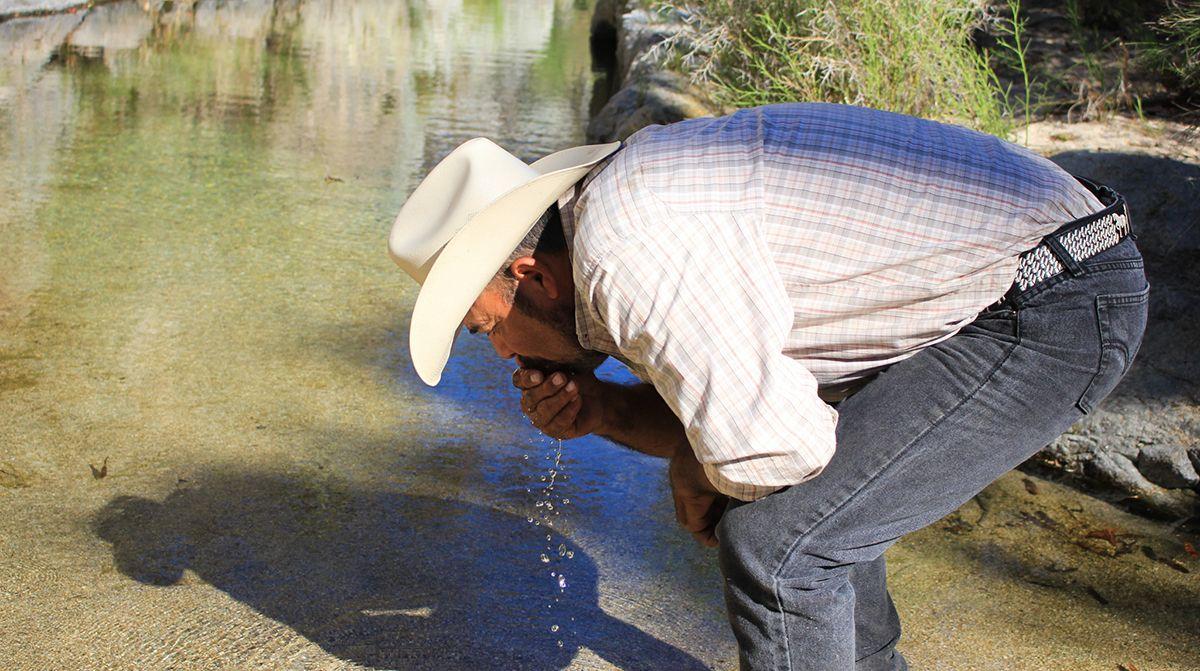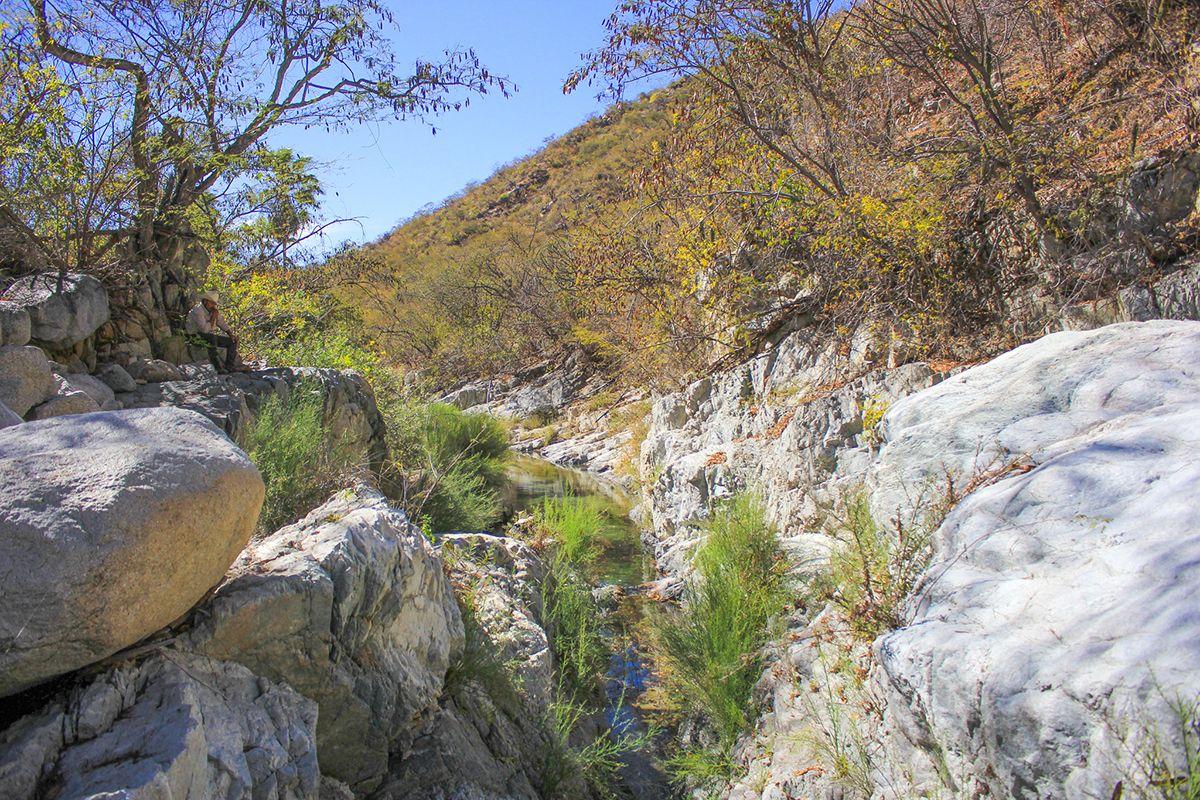The clean air, clear water, ranch culture and inhospitable landscapes of the Sierra La Laguna in northwestern Mexico have been threatened by the mining company Vista Gold Corp. since 2007, when they began carrying out exploration work in the buffer zone that modified the surface near Rancho Las Padercitas.
Since then, the citizen movement emerged under the slogan Defend the Sierra La Laguna, which brought together a large sector of the population and which did everything possible to stop the mining project, from demonstrations, sit-ins on the properties where it was intended to be installed and to road closures.
In a statement, the company said it intended to start operations in 2011 and produce 143,000 ounces of gold per year for the first five years and an estimated 1.2 million ounces of gold over the mine's 9-year lifespan. It also expresses the intention to make a positive contribution to the community through improvements in development.
From 2010 to 2019, the Paredones Amarilllos project changed to Concordia, then to Los Cardones and the company partnered with the Invecture Group. However, in all three attempts, they were denied approval of the environmental impact statement, land use change and social license, through the public consultation carried out by Semarnat.
In 2019, the process of land use change was stopped when the Secretariat of Agrarian, Territorial and Urban Development (Sedatu) handed over 751 hectares of the Sierra to the National Commission for Protected Natural Areas (Conanp) to manage.
In this way, “environmental conservation processes are consolidated and environmental impacts are avoided,” Sedatu said in a statement. Despite this achievement, which seeks to shield the Sierra from mining projects, the ranchers of the Sierra point out that the concessions are still in place and that it is not known how long the truce will last this time.
Causa Natura Media tried to contact the company Vista Gold through official channels registered in the directory of foreign capital companies of the Ministry of Economy, however, until press time of this edition, there was no response.

Sierra La Laguna was declared a Biosphere Reserve in 1994, however, two years later, the mining company benefited from concessions in the buffer zone with a validity of 50 years, with the possibility of being extendable for another 50 years, to extract mainly gold.
This Protected Natural Area covers an area of 112,437 hectares and concentrates ecosystems that group coniferous forests, rainforests, palm groves and scrubs unique to Baja California Sur; a diversity and abundance of species of wild flora and fauna and the presence of endemic, threatened and endangered species.
For ranchers who are dedicated to livestock and recently to ecotourism in Sierra La Laguna, such as Porfirio Díaz from Rancho La Rueda in the area known as La Burrera, a mining project is a death sentence for the ecosystem and for the 18 communities that inhabit it and a contradiction to the culture of conservation that has been promoted since the creation of the ANP.
Don Porfirio mentions that there are activities that prey on the ecosystem that can be repaired, such as illegal logging, but in the case of open-pit mining in an ecosystem as particular as this one, no. So if an open-pit mine is installed in Sierra La Laguna and destroyed, there is no way it will return to its original state.
Mining concessions and mining projects in ANP
Sierra La Laguna has only 10 of the 1,298 concessions granted within Protected Natural Areas (ANP) in Mexico, according to the Ministry of Economy, of which 419, or 32%, are concentrated in the northwest (Baja California, Baja California Sur, Chihuahua, Durango, Sinaloa and Sonora) and are located within 64 ANP in the region.
Manuel Llano, director of CartoCrítica, a civil organization dedicated to transparency and public access to environmental and georeferenced information, points out that concessions are the first of many steps that mining companies must take to exploit any resource, a situation with which he does not agree.
“It's absurd, it would have to be the last step once you have a water concession, a manifestation of environmental impact, agreements with the community, with the owners of the land, who benefit from indigenous consultation if it applies. Once you have exhausted all the procedures, the concession would have to be the last thing, but no, in Mexico it is the first procedure,” he explained.
Although the concessions do not guarantee that there will be mineral exploitation, but are granted to an individual to explore resources in the subsoil, they are important indicators that illustrate the voracity of mining in the territories and the risk that exists to communities and the environment.
However, the initial problem is that the current Mining Law allows mining concessions in Protected Natural Areas without the consent of communities, which is the main cause of environmental conflicts related to mining.
CartoCrítica has documented that up to 2021 there were at least 73 mining projects in Protected Natural Areas, of which 17 are open-pit mines, which was the one planned by the mining company in Sierra La Laguna and with the most destructive potential for opening large pits using explosives and heavy machinery.
Mining as a priority activity

One of the main privileges that the Mining Law grants to mining companies is the status of public utility activity and priority over any other activity, explains Manuel Llano, and based on this argument, all territory can be concessioned.
“If you interpret the national territory from the eyes of the Mining Law, it turns out that there are no forests, there is no water, there are no people, there are no cities, there is no private property, there is nothing. There are only concessioned areas, mining reserves, mining allotments and free land. Everything can be concessioned. That is the point of view from the Mining Law”.
Since Andrés Manuel López Obrador assumed the Presidency of Mexico, no new mining concessions have been granted, but new concession titles have been issued, that is, the concession area has not been extended, but it has been reduced or fractionated, which generates new titles, but that does not mean that there are fewer mining operations in the country.
However, Manuel Llano points out that there is an information gap that makes it difficult to access data to measure mining operations in the country, since while companies extract minerals from the subsoil that are owned by everyone, the Ministry of Economy has no obligation to keep a complete record of existing mining projects, disaggregated by type, magnitude, production, or the rights it paid to extract them.
Although Mexico joined the Extractive Industries Transparency Initiative (EITI) in 2017, an international standard that seeks to make the finances, permits, regulation and governance of extractive sectors transparent, the government fails to submit information disaggregated by mining project and violates the right of all people to access public information.
Resources and culture at risk

Through the Mining Act, not only the minerals in the area are granted, but also the water found on site during exploration and exploitation.
In Sierra La Laguna, the water that the company finds will automatically be owned by the mining company without the need to request a national water concession from the National Water Commission (Conagua).
In 2019, mining ranked first among the causes that generated Potentially Contaminated Sites, according to the Semarnat National Inventory of Contaminated Sites, and of 632 sites registered as highly contaminated, 84 were mining activities and 11 were in an ANP.
For Porfirio, mining represents extinction, since it would hog up water and there is a potential risk that it will contaminate the aquifers that supply the southern region of the peninsula. This is one of the main reasons why communities have remained united and have not succumbed to offers of employment and land purchase by mining companies.
Among the effects of an open-pit mine in Sierra La Laguna is damage to the landscape. The impacts of a mine would affect ecotourism activities in the region, which have been the communities' strongest sustenance in the face of the extinction of livestock farming as a result of water scarcity in the region.
Despite the fact that communities maintain a resounding no to mining companies, they have not received a definitive suspension of this type of project from the Ministry of Economy, so for them the risk of their return is latent, as they have done three times.
The ranchers say they hear detonations every 15 days and suspect that the company continues to operate stealthily very close to Rancho Las Padercitas, which is one of the most difficult areas to access by land.
“These people (mining companies) are not really interested in the richness of nature, the inhospitable, nor the lives of people, least of all,” says Porfirio, concluding that for ranchers, protecting Sierra La Laguna is protecting their own lives, that of their families and the ranching culture that the communities represent.
Initiatives to regulate mining activity
A group of organizations, communities, academics and citizens in general have formed the collective Cambiémosla Ya with the objective of promoting a series of reforms to the Mining Law so that it prioritizes life, health and human rights.
Because the legal framework allows the operation of mines in Protected Natural Areas because of their “preferential” nature, in 2021 the collective promoted an initiative that modifies article 46 of the General Law on Ecological Balance and Environmental Protection (LGEEPA) to prohibit the exploration and exploitation of hydrocarbons and/or minerals in ecological reserves, which was approved by the Chamber of Deputies, but has been postponed by the Senate of the Republic.
In addition, at a press conference, the collective reported that an initiative has just been sent with a draft decree that, although it is not focused on Protected Natural Areas, does regulate concessions for mining and water and provides tools for all communities that are fighting against mining interests in their territories.
Among the main changes is the elimination of the current preferential nature of mining, changes the order in which concessions are delivered and requires companies to have an environmental impact statement and a water concession before receiving it. In this way, Manuel Llano mentions that the way in which mining companies have access to the territory is changing.
If this Act were approved by the Chamber of Deputies and the Senate of the Republic, concessions in Protected Natural Areas would be maintained but could not be extended for another 50 years as established by the current legislation.
This reform seeks to provide greater legal tools for the anti-extractivist fight and its progress would mean another step towards the abolition of a regime of privileges and human rights violations that has characterized the mining sector for the last 30 years, said Jorge Pelaez, a member of Alliance #CambiemoslaYa,



Comentarios (0)